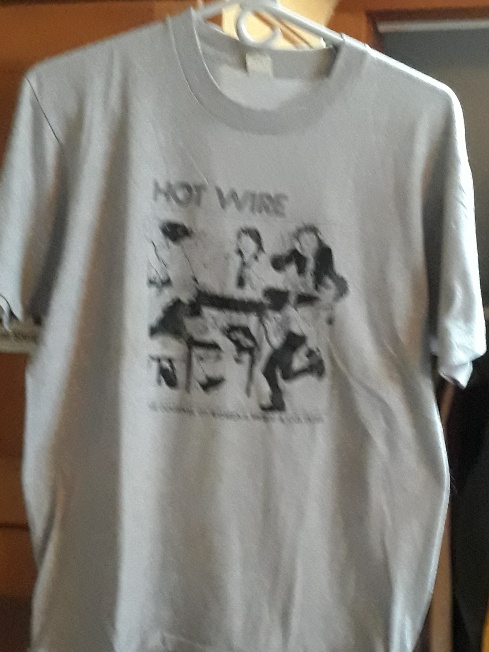December got away from me, as it often does, but I’m back! My last few posts have focused on music, and this one does too.
I was down to the last two music-related T-shirts from my D.C. days and couldn’t figure out how to tie them together. Should each one maybe get its own short post?

Then I got it: These two Ts, one from Ladyslipper Music and one from Hot Wire: The Journal of Women’s Music & Culture, both represent the national and international aspect of women’s music, but I had an up-close-and-personal relationship with both of them. I contributed a couple of articles to Hot Wire, including the one about the D.C. Area Feminist Chorus. At Lammas, I shared the upstairs office with Flo Hollis, a full-time Ladyslipper staffer, Lammas owner-manager Mary Farmer was a Ladyslipper distributor, and the code for the Lammas alarm system was Ladyslipper’s PO box number: 3124.
Turns out there was another close connection. Hot Wire has made all 30 of the issues it published between November 1984 and September 1995 available for free as downloadable PDFs, but rather than search each one for articles about Ladyslipper — I was 100% certain they had to have published at least one — I Googled. Imagine my surprise when the story I turned up had been written by me.
OMG. Turned out the date in that citation, May 1985, was wrong — Hot Wire didn’t publish an issue that month — but another reference to the same article had the correct date, March 1985. I downloaded the whole issue and read my own words from almost 37 years ago.

No question, it sounds like me. Many of the details came roaring back from my memory; others I’d never forgotten. Some of it I had no recollection of at all. What impresses me the most going on four decades later is the account of how the Ladyslippers dealt with a complete communications breakdown among the three full-time staff members in the winter of 1982–83. “What often happens in such situations,” I wrote, “is that one person leaves, and the level of tension drops for a while.” But at Ladyslipper, as staffer Sue Brown noted, “everyone was too stubborn to leave.”
So they went into counseling as a group. As I wrote, “They were not prepared for the speed and intensity with which issues came to the surface.” In retrospect, Liz Snow described the experience as “shocking.” They continued in counseling for “about ten months.” No one abandoned ship. Ladyslipper did not fall apart; it continued to develop as a major force in the women’s music and culture scene for as long as there was one.
By then I’d had plenty of experience with groups that foundered on their inability and/or unwillingness to work things through. I’d left the Women’s Center collective because the group dynamics were driving me crazy and I had no idea what to do about it. So Ladyslipper’s example was an inspiration: with hard work and, most likely, some help from the outside, we could get through the rough places.*

Which brings me back to those 30 issues of Hot Wire, all available for free download. What a treasure! They’re indispensable, sure, for anyone interested in the stars and rising stars of the women’s music scene of the 1980s and ’90s, but note how many articles are devoted to how-tos and behind-the-scenes movement building. We were starting from scratch in those days, pretty much building the plane as we were flying it, because there were so few experts to learn from.
At the same time, we knew we hadn’t come out of nowhere. Enough others had tended enough fires to leave sparks. It’s a relief to know that the fires are still being tended, and the sparks are still out there, like fireflies on a summer night.
If you want to leave a comment and don’t see a Leave a Reply box, click the title of the blog post (above) and then scroll to the bottom.
notes
* I don’t need to say (do I?) that these problems are not unique to feminist groups. After I moved to Martha’s Vineyard, I found no shortage of examples of groups that either fell apart or drove some of their most valuable members out. Not infrequently those who left would start a new group whose purpose duplicated or overlapped with the old. When the Vineyard finally discovered AIDS, around 1990, it became apparent that various complementary organizations either weren’t aware of or weren’t on speaking terms with each other. More about that later.
Wonderful to reclaim those incredible years. You made a huge contribution to the whole scene. Great memories.
LikeLiked by 1 person
I’d say “Wasn’t that a time” but I think that line’s been taken. 😉
LikeLike
Those were indeed some interesting times! I read everything printed, cover to cover, that Hot Wire published, had all of the wonderful floppy 45s and wish I still did; that’s a genuine loss for me. And my HW t-shirt… oh, I really miss that! Thank you so much for your contributions. Now if I only could get another one of those t-shirts!
LikeLiked by 1 person